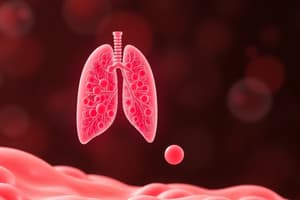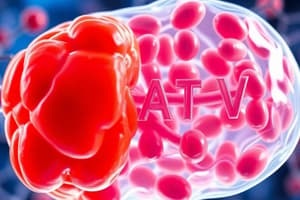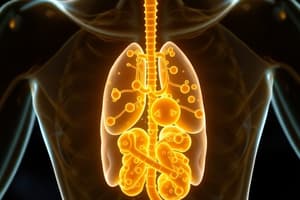Podcast
Questions and Answers
What is anaerobic respiration?
What is anaerobic respiration?
- Pathway that produces carbon dioxide only
- Pathway where glucose is broken down in the absence of oxygen (correct)
- Pathway where glucose is broken down in the presence of oxygen
- Pathway that produces water only
What are the 2 steps in anaerobic respiration?
What are the 2 steps in anaerobic respiration?
Glycolysis and fermentation
What is fermentation?
What is fermentation?
The chemical breakdown of a substance by microorganisms.
Where does fermentation occur in the cell?
Where does fermentation occur in the cell?
What are the 2 types of fermentation?
What are the 2 types of fermentation?
What types of cells undergo lactic acid fermentation?
What types of cells undergo lactic acid fermentation?
What products are made in lactic acid fermentation?
What products are made in lactic acid fermentation?
What products are made in alcoholic fermentation?
What products are made in alcoholic fermentation?
What are some industrial uses for alcoholic fermentation?
What are some industrial uses for alcoholic fermentation?
Give 3 differences between aerobic respiration and anaerobic respiration.
Give 3 differences between aerobic respiration and anaerobic respiration.
Flashcards are hidden until you start studying
Study Notes
Anaerobic Respiration
- Anaerobic respiration occurs in the absence of oxygen, breaking down glucose to produce energy.
- This process generates energy through two steps: glycolysis and fermentation.
Steps of Anaerobic Respiration
- Glycolysis: The initial step involves converting one glucose molecule into pyruvate, yielding 2 ATP.
- Fermentation: The second step involves the chemical breakdown of pyruvate by microorganisms in various environments.
Fermentation Explained
- Fermentation is the process by which bacteria, yeasts, or other microorganisms break down substances, often producing gases and heat.
- It can take place in food and beverages or within muscle cells.
Location of Fermentation
- In muscle cells, fermentation happens when oxygen levels are low, resulting in lactic acid production.
- In food and drinks, fermentation occurs when yeast or bacteria metabolize sugars, creating gases, acids, or alcohol.
Types of Fermentation
- Alcoholic Fermentation: Conducted by yeast and some bacteria, producing ethanol and carbon dioxide.
- Lactic Acid Fermentation: Occurs in human muscle cells and certain bacteria, producing lactic acid.
Products of Lactic Acid Fermentation
- The primary product is lactic acid, which is a key component of anaerobic metabolism in animals and some bacteria.
Cells Involved in Fermentation
- Lactic acid fermentation occurs in human muscle cells, fungi, and certain bacteria.
- Alcoholic fermentation is primarily carried out by yeast cells.
Products of Alcoholic Fermentation
- The main byproducts include ethanol, carbon dioxide, and other compounds such as tryptophol, which can be found in alcoholic beverages.
Industrial Uses of Alcoholic Fermentation
- Alcoholic fermentation is utilized in various industries for producing alcoholic drinks, ethanol fuel, and in skincare products.
Differences Between Aerobic and Anaerobic Respiration
- Key differences include the presence of oxygen, energy yield, and end products between the two types of respiration.
Studying That Suits You
Use AI to generate personalized quizzes and flashcards to suit your learning preferences.





